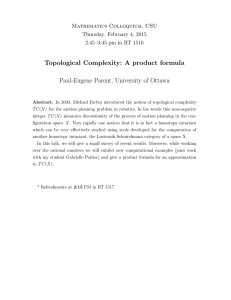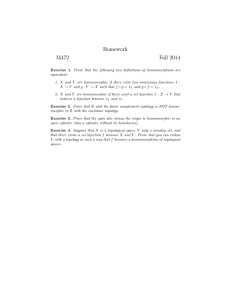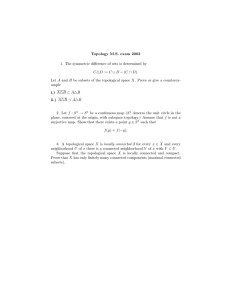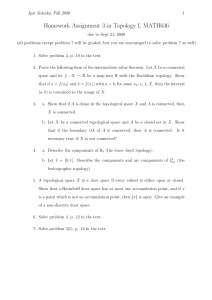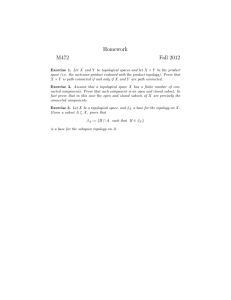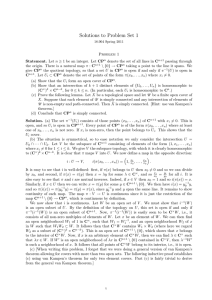Problem Set 1
advertisement
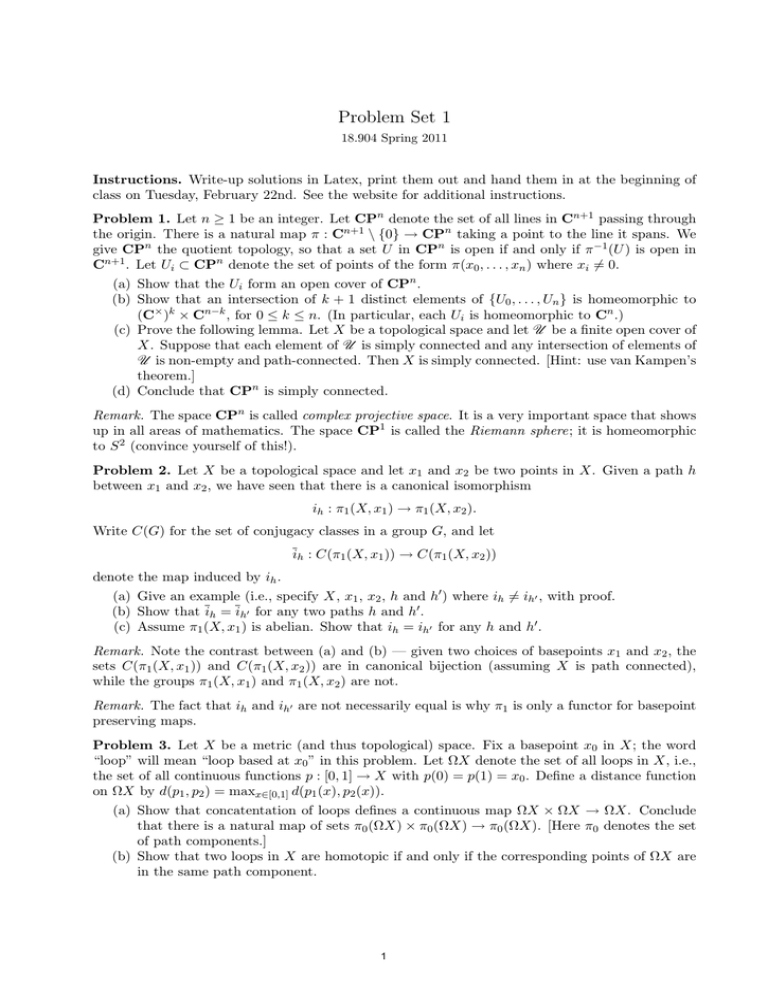
Problem Set 1
18.904 Spring 2011
Instructions. Write-up solutions in Latex, print them out and hand them in at the beginning of
class on Tuesday, February 22nd. See the website for additional instructions.
Problem 1. Let n ≥ 1 be an integer. Let CPn denote the set of all lines in Cn+1 passing through
the origin. There is a natural map π : Cn+1 \ {0} → CPn taking a point to the line it spans. We
give CPn the quotient topology, so that a set U in CPn is open if and only if π −1 (U ) is open in
Cn+1 . Let Ui ⊂ CPn denote the set of points of the form π(x0 , . . . , xn ) where xi = 0.
(a) Show that the Ui form an open cover of CPn .
(b) Show that an intersection of k + 1 distinct elements of {U0 , . . . , Un } is homeomorphic to
(C× )k × Cn−k , for 0 ≤ k ≤ n. (In particular, each Ui is homeomorphic to Cn .)
(c) Prove the following lemma. Let X be a topological space and let U be a finite open cover of
X. Suppose that each element of U is simply connected and any intersection of elements of
U is non-empty and path-connected. Then X is simply connected. [Hint: use van Kampen’s
theorem.]
(d) Conclude that CPn is simply connected.
Remark. The space CPn is called complex projective space. It is a very important space that shows
up in all areas of mathematics. The space CP1 is called the Riemann sphere; it is homeomorphic
to S 2 (convince yourself of this!).
Problem 2. Let X be a topological space and let x1 and x2 be two points in X. Given a path h
between x1 and x2 , we have seen that there is a canonical isomorphism
ih : π1 (X, x1 ) → π1 (X, x2 ).
Write C(G) for the set of conjugacy classes in a group G, and let
ih : C(π1 (X, x1 )) → C(π1 (X, x2 ))
denote the map induced by ih .
(a) Give an example (i.e., specify X, x1 , x2 , h and hi ) where ih = ih' , with proof.
(b) Show that ih = ih' for any two paths h and hi .
(c) Assume π1 (X, x1 ) is abelian. Show that ih = ih' for any h and hi .
Remark. Note the contrast between (a) and (b) — given two choices of basepoints x1 and x2 , the
sets C(π1 (X, x1 )) and C(π1 (X, x2 )) are in canonical bijection (assuming X is path connected),
while the groups π1 (X, x1 ) and π1 (X, x2 ) are not.
Remark. The fact that ih and ih' are not necessarily equal is why π1 is only a functor for basepoint
preserving maps.
Problem 3. Let X be a metric (and thus topological) space. Fix a basepoint x0 in X; the word
“loop” will mean “loop based at x0 ” in this problem. Let ΩX denote the set of all loops in X, i.e.,
the set of all continuous functions p : [0, 1] → X with p(0) = p(1) = x0 . Define a distance function
on ΩX by d(p1 , p2 ) = maxx∈[0,1] d(p1 (x), p2 (x)).
(a) Show that concatentation of loops defines a continuous map ΩX × ΩX → ΩX. Conclude
that there is a natural map of sets π0 (ΩX) × π0 (ΩX) → π0 (ΩX). [Here π0 denotes the set
of path components.]
(b) Show that two loops in X are homotopic if and only if the corresponding points of ΩX are
in the same path component.
1
(c) Construct a canonical bijection of sets π0 (ΩX) → π1 (X, x0 ). Show that this map is a
homorphism, in the sense that it respects the multiplications on the two sets (the one on
π0 (ΩX) constructed in (a) and the usual group operation on π1 (X, x0 )).
Remark. In fact, the bijection from (c) is just the first in a sequence: there are natural group
isomorphisms πn−1 (ΩX, x0 ) → πn (X, x0 ) for all n ≥ 1. [Here πn denotes the nth homotopy group.]
Remark. The above theory does not at all require X to be a metric space, it just simplifies the
definition of the topology on ΩX. When X is a general topological space, the appropriate topology
on ΩX is the “compact open topology.”
Problem 4. In this problem, we will show that every finitely presented group occurs as a funda­
mental group.
(a) Let G be a group, let a be an element of G and let N be the normal closure of the subgroup
generated by a. [Explicitly, N is the subgroup of G generated by all conjugates of a.] Let
Z → G be the map defined by 1 → a. Show that the amalgamated free product G ∗Z 1 is
isomorphic to G/N . [Here 1 denotes the trivial group.]
(b) Let X be a topological space with base point x0 and let i : S 1 → X be a loop based at x0 .
Let X i be the topological space obtained by attaching a 2-disc to X via i; that is, X i is the
quotient of X I D2 where an element x ∈ S 1 = ∂D2 is identified with i(x) ∈ X. Show that
π1 (X i , x0 ) is the quotient of π1 (X, x0 ) by the normal subgroup generated by the class of i.
[Hint: use van Kampen’s theorem.]
(c) Show that every finitely presented group occurs as a fundamental groups. [Hint: let G be a
finitely presented group. Pick a presentation. Start with a bouquet of circles, one for each
generator. Attach a 2-disc for each relation and apply (b).]
Remark. The requirement that the group be finitely generated is completely unnecessary. The
general case can be established by the same means.
Remark. There can be many very different homotopy types that have isomorphic fundamental
groups; for instance, both S 1 and S 1 ∨ S 2 have fundamental group Z. However, given a group G
there is a unique homotopy type with fundamental group G and contractible universal cover (or
equivalently, with all other homotopy groups vanishing).
Problem 5. Let G be a topological group; thus G is simulateneously a group and a topological
space, and the multiplication map G × G → G and inversion map G → G are continuous.
(a) Show that there is a unique group structure on π0 (G) such that the natural map G → π0 (G)
is a group homomorphism.
(b) Show that π1 (G, 1) is a commutative group. [Hint: if c is a loop in G based at 1 and g is
an element of G then t → gc(t) is a loop in G based at g. Using this you can slide one loop
along another to show that they commute in π1 .]
Problem 6. Let G = SL(2, R), the group of 2 × 2 real matrices with determinant 1. We can natu­
rally regard G as a closed subset of R4 , and thus (after a few simple verifications) as a topological
group. Let B ◦ ⊂ G be the subgroup of matrices which are upper-triangular with positive entries
on the diagonal. Let K ⊂ G be the subgroup of rotations matrices. [An element of G belongs to
K if and only if its two columns form an orthonormal basis of R2 .]
(a) Show that B ◦ is homeomorphic to R2 , and is thus contractible.
(b) Show that K is homeomorphic to S 1 .
(c) Show that the map B ◦ × K → G sending (b, k) to bk is a homeomorphism.
(d) Conclude that G is homotopy equivalent to S 1 , and thus has fundamental group Z.
Remark. The group SL(2, R) is better than just a topological group: as a topological space it is
actually a smooth manifold, and the group operations are smooth maps. Such topological groups
are called Lie groups. They are among the most important objects in all of mathematics.
2
MIT OpenCourseWare
http://ocw.mit.edu
18.904 Seminar in Topology
Spring 2011
For information about citing these materials or our Terms of Use, visit: http://ocw.mit.edu/terms.
